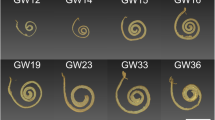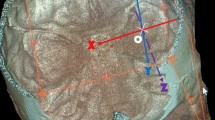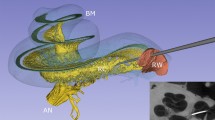Abstract
The sensory end-organs responsible for hearing and balance in the mammalian inner ear are connected via a small membranous duct known as the ductus reuniens (also known as the reuniting duct (DR)). The DR serves as a vital nexus linking the hearing and balance systems by providing the only endolymphatic connection between the cochlea and vestibular labyrinth. Recent studies have hypothesized new roles of the DR in inner ear function and disease, but a lack of knowledge regarding its 3D morphology and spatial configuration precludes testing of such hypotheses. We reconstructed the 3D morphology of the DR and surrounding anatomy using osmium tetroxide micro-computed tomography and digital visualizations of three human inner ear specimens. This provides a detailed, quantitative description of the DR’s morphology, spatial relationships to surrounding structures, and an estimation of its orientation relative to head position. Univariate measurements of the DR, inner ear, and cranial planes were taken using the software packages 3D Slicer and Zbrush. The DR forms a narrow, curved, flattened tube varying in lumen size, shape, and wall thickness, with its middle third being the narrowest. The DR runs in a shallow bony sulcus superior to the osseus spiral lamina and adjacent to a ridge of bone that we term the “crista reuniens” oriented posteromedially within the cranium. The DR’s morphology and structural configuration relative to surrounding anatomy has important implications for understanding aspects of inner ear function and disease, particularly after surgical alteration of the labyrinth and potential causative factors for Ménière’s disease.








Similar content being viewed by others
References
3D Slicer (2020) 3D Slicer. [Software]. Retrieved from https://www.slicer.org
Anniko M, Lundquist P (1977) The influence of different fixatives and osmolality on the ultrastructure of the cochlear neuroepithellum*. Arch Otorhinolaryngol 218:67–78
Bachor E, Karmody C (1995) The utriculo-endolymphatic valve in pediatric temporal bones. Eur Arch Otorhinolaryngol 252(3):167–171
Bast TH, Anson BJ (1949) The temporal bone and the ear. Thomas, C.C
Bronzati M, Benson RBJ, Evers SW, Witmer LM, Langer MC, Nesbitt SJ (2021) Deep evolutionary diversification of semicircular canals in archosaurs. Curr Biol. https://doi.org/10.1016/j.cub.2021.03.086
Curthoys I, Blanks R, Markham C (1982) Semicircular canal structure during postnatal development in cat and guinea pig. Annals of Otology, Rhinology and Laryngology 91(2):185–192
Curthoys IS, Markham CH, Curthoys EJ (1977) Semicircular duct and ampulla dimensions in cat, guinea pig and man. J Morphol 151(1):17–34. https://doi.org/10.1002/jmor.1051510103
Espinosa-Sanchez JM, Lopez-Escamez JA (2016) Menière’s disease. In Handbook of Clinical Neurology (Vol. 137, pp. 257–277). Elsevier B.V. https://doi.org/10.1016/B978-0-444-63437-5.00019-4
Fedorov A, Beichel R, Kalpathy-Cramer J, Finet J, Fillion- Robin J-C, Pujol S, Kikinis R (2012) 3D slicer as an image computing platform for the quantitative imaging network. Magn Reson Imaging 30(9):1323–1341
Fettiplace R (2017) Hair cell transduction, tuning, and synaptic transmission in the mammalian cochlea. Compr Physiol 7(4):1197–1227. https://doi.org/10.1002/cphy.c160049
Fritzsch B, Kopecky BJ, Duncan JS (2014) Development of the mammalian “vestibular” system: evolution of form to detect angular and gravity acceleration. In Development of Auditory and Vestibular Systems: Fourth Edition (pp. 339–367). Elsevier Inc. https://doi.org/10.1016/B978-0-12-408088-1.00012-9
Hallpike CS, Cairns H (1938) Observations on the pathology of Menicre’s syndrome. In Proceedings of the Royal Society of Medicine (Vol. 31, Issue Sept., pp. 55–74)
Hara M, Kimura RS (1993) Morphology of the membrana limitans. Annals of Otology, Rhinology & Laryngology 102(8):625–630. https://doi.org/10.1177/000348949310200811
Higuchi S, Sugahara F, Pascual-Anaya J, Takagi W, Oisi Y, Kuratani S (2019) Inner ear development in cyclostomes and evolution of the vertebrate semicircular canals. Nature 565(7739):347–350. https://doi.org/10.1038/s41586-018-0782-y
Hornibrook J, Mudry A, Curthoys I, Smith CM (2021) Ductus reuniens and its possible role in Menière’s disease. Otol Neurotol 42(10):1585–1593. https://doi.org/10.1097/MAO.0000000000003352
Igarashi M (1964) Comparative histological study of the reinforced area of the saccular membrane in mammals. Research Report. Naval School of Aviation Medicine (U.S.), 1–14
Jackler RK, Jan TA (2019) The future of otology. J Laryngol Otol 133(9):747–758. https://doi.org/10.1017/S0022215119001531
Janesick AS, Heller S (2019) Stem cells and the bird cochlea—where is everybody? Cold Spring Harb Perspect Med 9(4):a033183. https://doi.org/10.1101/cshperspect.a033183
Kikinis R, Pieper SD, Vosburgh K (2014) 3D slicer: a platform for subject-specific image analysis, visualization, and clinical support. Intraoperative Imaging Image-Guided Therapy 3(19):277–289
Kitamura K, Schuknecht HF, Kimura RS (1982) Cochlear hydrops in association with collapsed saccule and ductus reuniens. Ann Otol 91:5–13
Konishi S (1977) The ductus reuniens and utriculo-endolymphatic valve in the presence of endolymphatic hydrops in guinea-pigs. J Laryngol Otol 91(12):1033–1045
Köppl C, Manley GA (2019) A functional perspective on the evolution of the cochlea. Cold Spring Harbor Perspectives in Medicine 9(6). https://doi.org/10.1101/cshperspect.a033241
Köppl C, Wilms V, Russell IJ, Nothwang HG (2018) Evolution of endolymph secretion and endolymphatic potential generation in the vertebrate inner ear. Brain Behav Evol 92(1):1–31. https://doi.org/10.1159/000494050
Li H, Rajan GP, Shaw J, Rohani SA, Ladak HM, Agrawal S, Rask-Andersen H (2021a) A synchrotron and micro-ct study of the human endolymphatic duct system: is Meniere’s disease caused by an acute endolymph backflow? Front Surg 8(662530). https://doi.org/10.3389/fsurg.2021.662530
Li H, Schart-Moren N, Rajan G, Shaw J, Rohani SA, Atturo F, Ladak HM, Rask-Andersen H, Agrawal S (2021b) Vestibular organ and cochlear implantation–a synchrotron and micro-CT study. Frontiers in Neurology 12(663722). https://doi.org/10.3389/fneur.2021.663722
Lundberg YW, Xu Y, Thiessen KD, Kramer KL (2015) Mechanisms of otoconia and otolith development. Dev Dyn 244:239–253. https://doi.org/10.1002/dvdy
Luo Z-X, Crompton AW, Lucas SG (1995) Evolutionary origins of the mammalian promontorium and cochlea. J Vertebr Paleontol 15(1):113–121. https://doi.org/10.1080/02724634.1995.10011211
Luo Z-X, Schultz JA, Ekdale EG (2016) Evolution of the middle and inner ears of mammaliaforms: the approach to mammals. In Evolution of the Vertebrate Ear (pp. 139–174). https://doi.org/10.1007/978-3-319-46661-3_6
Manley GA (2012) Evolutionary paths to mammalian cochleae. J Assoc Res Otolaryngol 13(6):733–743. https://doi.org/10.1007/s10162-012-0349-9
Morimoto N, Kunimatsu Y, Nakatsukasa M, Ponce de León MS, Zollikofer CPE, Ishida H, Sasaki T, Suwa G (2020) Variation of bony labyrinthine morphology in Mio−Plio−Pleistocene and modern anthropoids. Am J Phys Anthropol 173(2):276–292. https://doi.org/10.1002/ajpa.24098
Mukherjee P, Cheng K, Curthoys I (2019) Three-dimensional study of vestibular anatomy as it relates to the stapes footplate and its clinical implications: an augmented reality development. J Laryngol Otol 133(3):187–191. https://doi.org/10.1017/S0022215119000239
Oshima K, Grimm CM, Corrales CE, Senn P, Martinez Monedero R, Géléoc GSG, Edge A, Holt JR, Heller S (2007) Differential distribution of stem cells in the auditory and vestibular organs of the inner ear. J Assoc Res Otolaryngol 8(1):18–31. https://doi.org/10.1007/s10162-006-0058-3
Pender DJ (2009) A model analysis of static stress in the vestibular membranes. Theoretical Biology and Medical Modelling 6(1). https://doi.org/10.1186/1742-4682-6-19
Pender DJ (2014a) A model design for the labyrinthine membranes in mammals. Laryngoscope 124(6):E245–E249. https://doi.org/10.1002/lary.24516
Pender DJ (2014b) Membrane stress proclivities in the mammalian labyrinth. International Archives of Otorhinolaryngology 18(4):398–402. https://doi.org/10.1055/s-0034-1385846
Pender DJ (2015) Membrane stress in the human labyrinth and Meniere disease: a model analysis. International Archives of Otorhinolaryngology 19(4):336–342. https://doi.org/10.1055/s-0035-1549157
Pender DJ (2018) Suspensory tethers and critical point membrane displacement in endolymphatic hydrops. International Archives of Otorhinolaryngology 22(3):214–219. https://doi.org/10.1055/s-0037-1604474
Pender DJ (2019) A model of viscoelastoplasticity in the cochleo-saccular membranes. Laryngoscope Investigative Otolaryngology 4(6):659–662. https://doi.org/10.1002/lio2.318
Perlman H (1940) The saccule: observations on a differentiated reinforced area of the saccular wall in man. Arch Otolaryng 32:678–691
Pixologic (2020) Zbrush. [Software]. Version 4R8. Retrieved from https://pixologic.com
Plontke SK, Rahne T, Curthoys IS, Håkansson B, Fröhlich L (2021) A case series shows independent vestibular labyrinthine function after major surgical trauma to the human cochlea. Commun Med1(1). https://doi.org/10.1038/s43856-021-00036-w
Schmidt RS, Fernández Cés (1962) Labyrinthine DC potentials in representative vertebrates. J Cell Comp Phys 59(3):311–322. https://doi.org/10.1002/jcp.1030590311
Smith CM, Curthoys IS, Mukherjee P, Wong C, Laitman JT (2021) Three‐dimensional visualization of the human membranous labyrinth: the membrana limitans and its role in vestibular form. The Anatomical Record, ar.24675. https://doi.org/10.1002/ar.24675
Spoor F, Zonneveld F (1998) Comparative review of the human bony labyrinth. American Journal of Physical Anthropology, Suppl 27:211–251. https://doi.org/10.1002/(SICI)1096-8644(1998)107:27+%3c211::AID-AJPA8%3e3.0.CO;2-V
Urciuoli A, Zanolli C, Beaudet A, Dumoncel J, Santos F, Moyà-Solà S, Alba DM (2020) The evolution of the vestibular apparatus in apes and humans. Elife 9:1–33. https://doi.org/10.7554/eLife.51261
Uzun H, Curthoys IS, Jones AS (2007) A new approach to visualizing the membranous structures of the inner ear - High resolution X-ray micro-tomography. Acta Otolaryngol 127(6):568–573. https://doi.org/10.1080/00016480600951509
Uzun-Coruhlu H, Curthoys IS, Jones AS (2007) Attachment of the utricular and saccular maculae to the temporal bone. Hear Res 233(1–2):77–85. https://doi.org/10.1016/j.heares.2007.07.008
Walther LE, Wenzel A, Buder J, Bloching MB, Kniep R, Blödow A (2014) Detection of human utricular otoconia degeneration in vital specimen and implications for benign paroxysmal positional vertigo. Eur Arch Otorhinolaryngol 271(12):3133–3138. https://doi.org/10.1007/s00405-013-2784-6
Warmerdam TJ, Schröder FHHJ, Wit HP, Albers FWJ (2003) Perilymphatic and endolymphatic pressures during endolymphatic hydrops. Eur Arch Otorhinolaryngol 260(1):9–11. https://doi.org/10.1007/s00405-002-0518-2
Wilms V, Köppl C, Söffgen C, Hartmann AM, Nothwang HG (2016) Molecular bases of K + secretory cells in the inner ear: shared and distinct features between birds and mammals Sci Rep 6. https://doi.org/10.1038/srep34203
Yamakawa K (1938) Uber die pathologisch Veranderung bei einem Ménière-Kranken. J Otorhinolaryngol Soc Jpn 4:2310–2312
Yamane H, Takayama M, Sunami K, Sakamoto H, Mochizuki K, Inoue Y (2009) Three-dimensional images of the reuniting duct using cone beam CT. Acta Otolaryngol 129(5):493–496. https://doi.org/10.1080/00016480802294393
Acknowledgements
The authors acknowledge the facilities and the scientific and technical assistance of Microscopy Australia at the Australian Centre for Microscopy & Microanalysis at the University of Sydney. We also thank the Institute of Anatomy and Cell Biology, Martin Luther University Halle-Wittenberg, Halle (Saale), Germany (Director Prof. Dr. med. Heike Kielstein) for providing the temporal bone specimen for Fig. 8. CT scan data of human crania used for Group 2 were provided by Dr. Ashley Hammond and Dr. Sergio Almécija, with the resources and coordination of the American Museum of Natural History’s Microscopy and Imaging Facility. In particular, we thank Morgan Chase, Andrew Smith, and Alisha Anaya for assistance during scanning.
Funding
This work was supported by an NSF Doctoral Dissertation Research Improvement Grant (award #: 2051335); the Garnett Passe and Rodney Williams Memorial Foundation; the Graduate Center, City University of New York; the Center for Anatomy and Functional Morphology at the Icahn School of Medicine at Mount Sinai; and the New York Consortium in Evolutionary Primatology.
Author information
Authors and Affiliations
Corresponding author
Ethics declarations
Conflict of Interest
The authors declare no competing interests.
Outside the submitted work, the following financial activities are declared:
SKP (last 3 years):
-
Personal Consultancies: AudioCure Pharma GmbH, Berlin, Germany.
-
Institutional research collaborations: MEDEL, Austria; Cochlear, Australia; Oticon Medical, Denmark; Schwabe Arzneimittel, Germany.
-
Travel support for lectures: MED-EL, Austria.
-
Honorary for Lectures or Session Moderations: Infectopharm, Germany; Merck Serono, Darmstadt, Germany; Schwabe Arzneimittel, Germany
Additional information
Publisher's Note
Springer Nature remains neutral with regard to jurisdictional claims in published maps and institutional affiliations.
Rights and permissions
About this article
Cite this article
Smith, C.M., Curthoys, I.S., Plontke, S.K. et al. Insights into Inner Ear Function and Disease Through Novel Visualization of the Ductus Reuniens, a Seminal Communication Between Hearing and Balance Mechanisms. JARO 23, 633–645 (2022). https://doi.org/10.1007/s10162-022-00858-y
Received:
Accepted:
Published:
Issue Date:
DOI: https://doi.org/10.1007/s10162-022-00858-y




